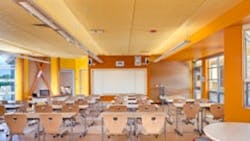Everyone has dealt with this situation: A new restaurant opens up. There is a lot of buzz about it, you try it, and walk away disappointed. You ask yourself, "Was what I got really worth what I paid? Did I get value for my money?"
This is a proposition that a superintendent, facilities manager or business manager deals with every time an expenditure is made at an education institution. A need is identified and assessed, the application verified, the execution prepared. Now, the school needs to get the best value.
When the items to be acquired are from a basic commodity group, such as copy paper, toner or office supplies, it is fairly simple to evaluate the value for money. You know the item is a consumable, will probably be used by every department in the system, and is a fairly benign purchase. Price, delivery and service are the core ingredients to the decision. When it is used up, the school buys more or depends on some replenishment program through supplier agreements to ensure that there is always product available for the staff.
Value for money
With capital equipment, other factors begin to work into the decision. For some items, it can be a repair or replace option. Because depreciation schedules do not factor into public tax-dollar expenditures, does it make sound financial sense to repair what is owned, extend the useful life of the item, and wait to see what new features and benefits, if any, are coming down the road and defer a purchase until then? Or, are the new features and benefits here right now, and would deferring that purchase put the system behind?
What factors go into the "value for money" discussion and decision?
•Is this a real need or just on someone’s wish list? With operating and capital budgets under greater scrutiny in today’s fragile economy, is this expenditure necessary to accomplish the educational mission? In the case of a new facility replacing a post-World War II building, both the envelope and the contents represent a real need. The learning environment is state-of-the art, the curriculum delivery systems are real-time, the staff and faculty are all fully trained in how to use the new "tool box," and the students are expecting a safe, clean, aesthetically pleasing space to go about their work.
•Who is the provider for goods and services? Does the education institution know the provider? Does the provider understand the school’s needs and offer sound, candid advice as to which product should be considered? Can the provider work within the business systems, understand procurement policies, and offer other transactional vehicles such as state contracts, commodity buying consortiums? Do they view the relationship with the institution as long-term or is this a "one and done" opportunity for them?
•What can the school expect from the purchase? Will the institution see benefits over a period of time, or will the purchase become outdated, non-functional or obsolete? Will it provide a value-added component that is not really part of the core need, or will it become an unexpected overhead factor after it is put into use? Will the district or campus save money with the ownership of this item, or will it cost time?
This is the conundrum. Should initial cost be the sole driver in the decision, or should the institution or campus take a longer view to see that the taxpayers of today and tomorrow get their money’s worth?
For building services, such as HVAC, lighting, even some sanitary systems, the savings over initial cost are expressed in lower energy costs and usage, a more comfortable working and teaching environment, lower maintenance costs and a longer service life. These components usually are quantifiable and easy to track.
For technology-based solutions, it may be more difficult to determine the value vs. expense. Software compatibility, access to applications, ease of use and completeness of content are a few things to consider. The answer may be in the improvement in test scores, truancy reduction and graduation rates. Overall student performance may be the only real gauge.
Talking furniture
For fixtures, furnishings and equipment, comparing initial cost with the cost of ownership over a life cycle can be more challenging. It may be the functionality of the furnishings that provides the greatest return on investment.
In today’s collaborative learning environment, seating, desks, tables and storage have to be reconfigurable in a moment’s notice and be done by the students without the facility department’s assistance.
The Business and Institutional Furniture Manufacturers Association (BIFMA) has a committee developing standards for sizing and weight loads for educational seating, and this will likely evolve into a set of suggested requirements for educational furnishings. Suppliers that want to be considered will have to meet or exceed future BIFMA standards. Occupational therapists are more common in school districts than ever before and provide a lot of input regarding proper ergonomics, movement and student development.
Sustainability is an integral part of any FF&E equation. Is the supplier a GREENGUARD, ISO14001, or Global Compact supporter? Does its operation represent "best practices" for the segment they are in? Will one product or solution contribute more to a student’s well-being than another’s? All of the above become points to consider when preparing to expend public monies.
So, what is the right definition of "value for money?" Suitability, durability, safety, and ease of maintenance are among the characteristics that come to mind first. Other features that may be factors: gauge of steel, weight, type of glide or caster or color selection. One could say the real definition is a collection of values that suits all the criteria that a school or university has laid out for that specific need.
Spellman is national sales manager for VS America, Inc., Charlotte, N.C. He can be reached at [email protected].
